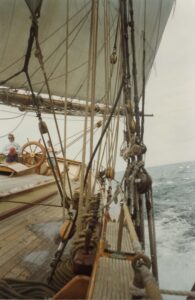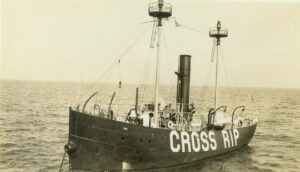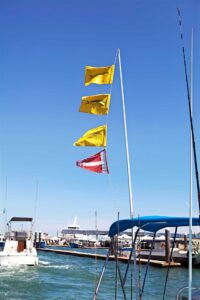When Herman Melville wrote Moby Dick in 1851, he was at the height of his success as a writer with a knack for mixing his years at sea with building fictional characters based on his shipmates. At the same time, New England Whaling and the American whaling fleet from New England was also reaching its peak. Whales were hunted for their blubber, a thick layer of fat that was rendered into oil by boiling it in water. Whale oil provided the primary source of lubrication for machinery during the Industrial Revolution in the United States and Europe.
The following year, Melville visited Nantucket for the first time. That island was the birthplace of the commercial whaling fishery in New England in 1690. In those early days in Nantucket, whaling was done by lookouts on shore. Once a whale was sighted, a rowboat was pushed off the beach carrying a supply of harpoons and lances. A crew of four rowed out to the whale so the harpooner could catch the whale and lance it to death. The whale was towed back to shore, beached, flensed and “tryed out.” Flensing was the process of cutting away the blubber; “trying” meant heating it in cauldrons to make whale oil.
The whale species that were hunted off Nantucket were called the “right whale.” They were actually different types of baleen whales, but given the name right whale, because they were the perfect cetacean for that early whale fishing method. Right whales swam close to shore preferring shallow bays and protected areas to feed.
They caught food by skimming slowly along the water’s surface with their mouth wide open. Once filled with water, they shut their large mouth and used baleen plates in their jaws as a sieve as they expelled seawater. Left behind were krill and tiny crustaceans to swallow. Baleen, also known as whalebone, also became a commodity, because it was stiff yet flexible. It was sought after as a component for ribs in parasols, stays in corsets and whips for horse-drawn buggies.
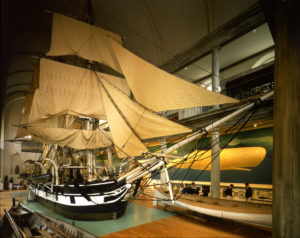 Before long the fishery of slow-moving right whales off Nantucket was depleted. During the 1700s, New England mariners took to sailing ships in search of whales and hunted them as far away as Baffin Island, Greenland, the Azores, West Africa and Brazil. Instead of towing the whales ashore to be rendered, “trying pots” were carried on the ships for rendering the blubber, and whale oil was stored aboard in barrels during the long months of the voyage.
Before long the fishery of slow-moving right whales off Nantucket was depleted. During the 1700s, New England mariners took to sailing ships in search of whales and hunted them as far away as Baffin Island, Greenland, the Azores, West Africa and Brazil. Instead of towing the whales ashore to be rendered, “trying pots” were carried on the ships for rendering the blubber, and whale oil was stored aboard in barrels during the long months of the voyage.
Sailing far away from New England, whalers began harpooning other whale species. Whalers from Nantucket, New Bedford and New London first rounded Cape Horn in 1791 and hunted for sperm whales off Chile and Peru. The sperm whale was the most valuable prize in whaling, because each skull contained a gigantic spermaceti organ. This organ was a tank for holding spermaceti, a liquid wax that whales used for echo location, communication and buoyancy. Each head contained up to 500 gallons of spermaceti and when processed into sperm oil, it produced the finest product then available for lubricating watches and sewing machines and for lighting oil lamps and making candles.
In 1820, the first New Bedford whaling ship hunted sperm whales on the Japan Ground, which was located halfway between Hawaii and Japan. Soon the Hawaiian Islands became the ideal waypoint for stocking up on fresh local produce and water, making ship repairs and finding new crew.
Was the sperm whale so valuable to justify sailing all the way to Japan to hunt for it? Today, a barrel of Brent crude oil is just under $70 on the spot market. In 1823, a barrel of sperm oil sold for $200 (adjusted for the value of today’s dollar), and by 1855 it had risen to more than $1,400 a barrel. Clearly, cheaper alternatives for lighting oil lamps needed to be found.
When Edwin Drake drilled the first commercial oil well in Titusville, PA, in 1859, he was searching for petroleum. When refined, crude oil produced kerosene, which was a very inexpensive alternative to sperm whale oil. During the Civil War, the Confederate navy and its raiders destroyed many Yankee whalers and decimated the fleet. The New England whaling industry never recovered, but the romance of whaling and going to sea in those wooden sailing ships lives on.
![]() EXPERIENCE THE MARITIME SPIRIT OF MASSACHUSETTS
EXPERIENCE THE MARITIME SPIRIT OF MASSACHUSETTS
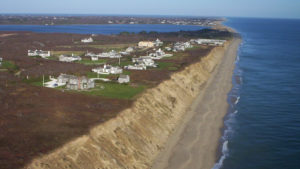
The Massachusetts Whale Trail links nearly 40 museums, attractions, whale-watching excursions, historic sites and tours dedicated to our special connection with these creatures of the deep. Discover this one-of-a-kind collection of whaling sites, stories and adventures. Highlights of the trail include:
Cape Ann Whale Watch
415 Main St., Gloucester
800-877-5110
Cape Cod Museum of Natural History
869 Main St., Brewster
800-877-3867
Herman Melville’s New Bedford Walking Tour
37 N. 2nd St., New Bedford
508-996-4095
Hyannis Whale Watcher Cruises
269 Millway, Barnstable
800-287-0374
The Historic Mariner’s Home and Whaling Museum
18 Johnny Cake Hill, New Bedford
508-997-0046
Melville Trail
780 Holmes Road, Pittsfield
413-442-1793
Nantucket Whaling Museum
13 Broad St., Nantucket
508-228-1894



